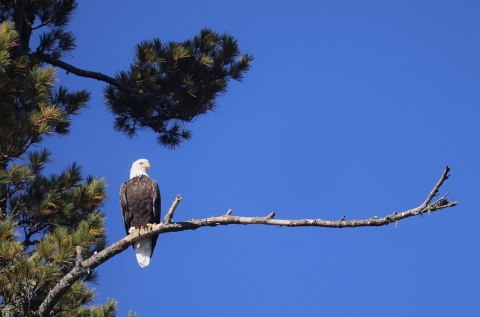What We Do
The U.S. Fish and Wildlife Service works to conserve and manage both bald eagle and golden eagle populations to assure both species continue to thrive.
Management and Conservation
Along with our internal work to conserve and manage eagles, the USFWS also works with partners on multiple eagle-focused working groups.
Our Services
Guidance
The Service provides information and recommendations on living around eagles and working around eagles to help protect eagles and facilitate compliance with the Bald and Golden Eagle Protection Act.
More about Living and working Near Eagles
Eagle Permits
The U.S. Fish and Wildlife Service is committed to the conservation of eagles throughout the United States. We understand that certain activities and endeavors that people undertake that are otherwise legal and abide by other laws may result in unintentional (also called non-purposeful or incidental) harm to eagles. This harm can be in the form of disturbance to eagles, encroachment on eagle nests, and loss of individual eagles, and is often called "take."
The term "take" under the Bald and Golden Eagle Protection Act "means pursue, shoot, shoot at, poison, wound, kill, capture, trap, collect, destroy, molest, or disturb" an eagle (50 CFR 22.6). Disturb means "to agitate or bother a bald or golden eagle to a degree that causes, or is likely to cause, based on the best scientific information available, (1) injury to an eagle, (2) a decrease in its productivity, by substantially interfering with normal breeding, feeding, or sheltering behavior, or (3) nest abandonment, by substantially interfering with normal breeding, feeding, or sheltering behavior" (50 CFR 22.6).
Take of eagles in any form, even if unintended, is a violation of the Bald and Golden Eagle Protection Act.
However, there are regulations that allow the U.S. Fish and Wildlife Service to permit take of bald eagles or golden eagles (50 CFR 22) to allow for compliance with the Bald and Golden Eagle Protection Act when specific criteria and conditions are met. The take permitting system under the Bald and Golden Eagle Protection Act provides an effective means for the Service to work proactively with public and private entities to reduce this unintentional harm to eagles and, when necessary, assure it is offset. It also provides a mechanism to gain critical data to track mortality rates and causes. In return for working with the Service to reduce harm to eagles, a permittee is provided a guarantee that they will not be prosecuted for the loss or disturbance of an estimated number of eagles.
Eagle Permit Types Available:
The U.S. Fish and Wildlife Service may issue permits for the take, possession, or transportation of bald and golden eagles, as well as their parts, nests, and eggs. A summary of all eagle permits available, please visit the Migratory Bird Permits Program page. To apply for an eagle permit of any type, please visit ePermits.
For more information about eagle incidental take, disturbance take, and nest take permits, please check out the links below:
Eagle Incidental Take Permits for Wind Energy
Eagle Incidental Take Permits for Power Lines
Eagle Disturbance Take and Nest Take Permits
Eagle Feathers and Parts for Native Americans
Native Americans can request and possess eagle feathers and parts for religious and cultural purposes from our National Eagle Repository.
Crimes Against Eagles
Our National Fish and Wildlife Forensics Lab examines, identifies, and compares evidence using a wide range of scientific procedures and instruments, in the attempt to link suspect, victim, and crime scene with physical evidence.
National Fish and Wildlife Forensics Lab
Need Assistance with Bird Concerns other than Eagles?
Some other services the U.S. Fish and Wildlife Service provides is assistance with migratory bird permitting.
Our Projects and Research
Our Laws and Regulations
Both bald eagles and golden eagles are protected by the Bald and Golden Eagle Protection Act (Eagle Act) and the Migratory Bird Treaty Act (MBTA).
The Bald and Golden Eagle Protection Act also has regulations for permitting take, possession, and transportation of bald eagles or golden eagles (50 CFR 22). These regulations allow for permitting of "the taking, possession, and transportation within the United States of bald eagles (Haliaeetus leucocephalus) and golden eagles (Aquila chrysaetos) and their parts, nests, and eggs for scientific, educational, and depredation control purposes; for the religious purposes of American Indian tribes; and to protect other interests in a particular locality" as well as governing "the transportation into or out of the United States of bald and golden eagle parts for scientific, educational, and Indian religious purposes."
2024 Eagle Regulations Revision
On February 12, 2024, the Service published in the Federal Register a final rule and final environmental assessment that revises permitting for eagle incidental take and eagle nest take under the Bald and Golden Eagle Protection Act. The purpose of this rulemaking was to increase the efficiency and effectiveness of permitting, improve clarity for the regulated community, and increase the conservation benefit for eagles. In addition to continuing to authorize specific permits, we created general permits for certain activities under prescribed conditions, including qualifying wind energy generation projects, power line infrastructure, activities that may disturb breeding bald eagles, and bald eagle nest take. General permits simplify and expedite the permitting process for activities that have relatively consistent and low risk to eagles and well-established avoidance, minimization, and compensatory mitigation measures. We also made improvements to the specific permit application review process and requirements, revised permit fees, and clarified definitions.
Info on Eagle Act Regulation Revisions






